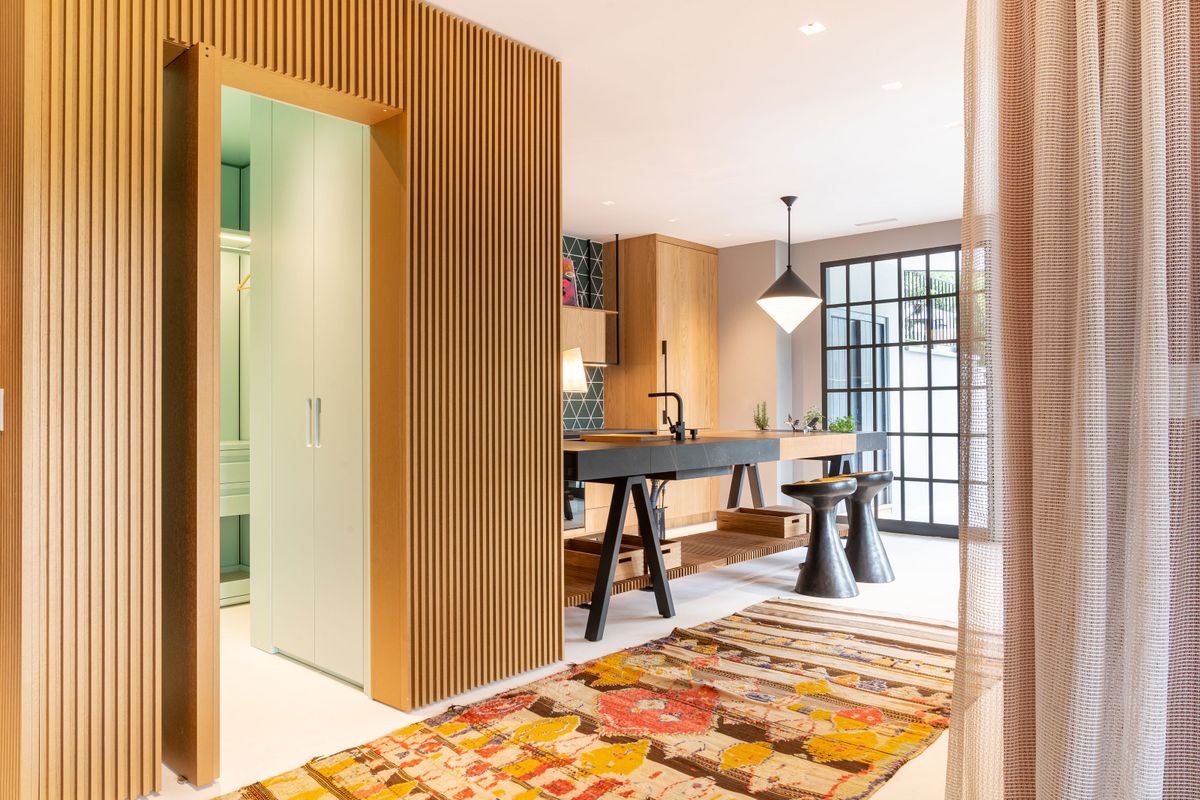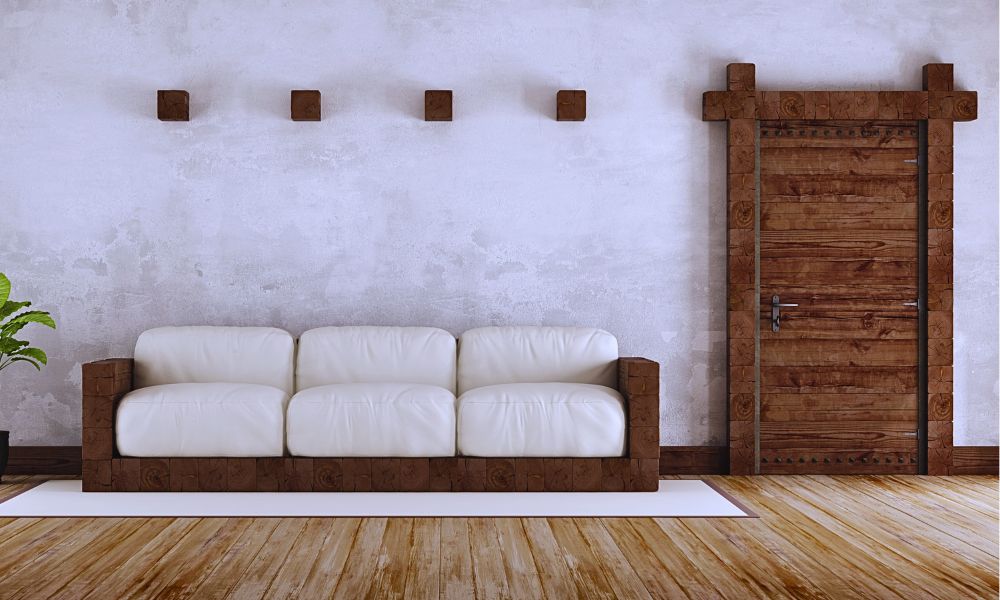Concealing the Doorway

You want to hide that bathroom door in your living room, right? Don’t worry, it’s totally doable! There are tons of ways to make it disappear into the background, like it’s never even been there. We’re gonna talk about some super cool tricks to make that happen.
Blending the Door with Decor
The key here is to make the door look like it’s part of the wall. This is all about using color, texture, and patterns to create a seamless look.
- Painting the Door: The easiest way to make the door disappear is to paint it the same color as the wall. You can even use a slightly darker or lighter shade to create a subtle effect. Think about using a matte finish to avoid any glare that might give away the door’s location.
- Wallpapering the Door: If you want to add some personality to your living room, wallpapering the door is a great option. Choose a wallpaper that complements the existing wall decor and extends it to the door. Just make sure the wallpaper you choose is durable enough for a high-traffic area like a door.
- Adding Decorative Elements: You can also use decorative elements like moldings, trim, or even wallpaper borders to visually integrate the door with the wall. For example, adding a decorative molding around the door frame can create a more cohesive look.
Using Mirrors and Artwork
Another trick is to use mirrors or artwork to distract attention from the door.
- Mirrors: Placing a mirror strategically near the door can create the illusion of depth and space, drawing the eye away from the door itself. Think about using a large mirror that covers the entire wall or a series of smaller mirrors arranged in a pattern. Mirrors can also create a more spacious feel in your living room.
- Artwork: Hanging artwork above or beside the door can also effectively camouflage its presence. Choose a piece that complements the style of your living room and draws attention away from the door. You can even use a large piece of artwork to completely cover the door.
Integrating the Door into a Built-in Unit
This is a more permanent solution, but it can be incredibly effective.
- Built-in Bookshelf: This is a classic way to hide a door. You can build a bookshelf around the door, making it look like just another section of the bookshelf. Make sure the bookshelf is deep enough to accommodate the door’s thickness. You can even add a small hinge to the bookshelf’s top shelf so you can easily access the bathroom.
- Custom Wall Unit: If you’re feeling ambitious, you can create a custom wall unit that incorporates the door. This could include a combination of shelves, cabinets, and drawers, all designed to seamlessly blend with the door. You can also use this opportunity to add storage space to your living room.
Creating a False Wall: How To Hide Bathroom Door In Living Room

Building a false wall to hide the bathroom door is a popular choice for those seeking a more permanent and visually appealing solution. This method involves constructing a new wall in front of the existing bathroom door, creating a seamless integration into the living room’s design.
Construction Process
Constructing a false wall involves several steps, including planning, material gathering, and installation.
Materials
- Framing lumber: This is the backbone of the false wall, providing structural support. Choose lumber based on the wall’s dimensions and desired thickness.
- Drywall: This material covers the framing, creating a smooth and finished surface. Select drywall based on the desired thickness and fire resistance.
- Insulation: This helps to improve the wall’s thermal and acoustic properties, reducing noise and temperature fluctuations.
- Tape, mud, and paint: These materials are used to finish the drywall, creating a seamless and aesthetically pleasing surface.
- Hardware: This includes screws, nails, brackets, and other components necessary for assembly and installation.
- Hidden door system: This includes the door itself, the frame, and the hinges, designed to be concealed within the false wall.
Tools
- Measuring tape: Essential for accurate dimensions and layout.
- Level: Ensures that the wall is plumb and straight.
- Saw: For cutting lumber and drywall.
- Drill: For driving screws and installing hardware.
- Screwdriver: For attaching the door system and other hardware.
- Hammer: For driving nails and securing framing.
- Safety gear: Eye protection, gloves, and dust mask are crucial for safety during construction.
Installing a Hidden Door
Installing a hidden door within the false wall requires careful planning and execution. The door system needs to be integrated seamlessly with the wall’s structure, ensuring smooth operation and a concealed appearance.
Steps
- Plan the door placement: Determine the exact location of the hidden door within the false wall. Consider factors such as access, visibility, and overall design.
- Install the door frame: Secure the door frame to the false wall framing, ensuring a tight fit and proper alignment.
- Install the door: Mount the hidden door to the frame, ensuring smooth operation and a flush finish with the wall surface.
- Finish the wall: Install drywall, tape, mud, and paint to create a seamless finish and conceal the door.
Advantages and Disadvantages
- Advantages:
- Enhanced privacy: The false wall effectively conceals the bathroom door, providing a greater sense of privacy.
- Aesthetic appeal: The false wall can be customized to match the existing décor, creating a visually cohesive and seamless look.
- Increased space: The false wall can create a more spacious and organized living room by incorporating storage or shelving units.
- Disadvantages:
- Cost: Building a false wall can be more expensive than other concealment methods.
- Complexity: The construction process requires significant effort and skill.
- Space consumption: The false wall will consume some living room space.
Camouflaging the Door

If you’re looking to seamlessly blend your bathroom door into the living room, camouflaging is the way to go. It’s all about making the door disappear into the background, becoming an integral part of the room’s design.
Disguising the Door as Furniture
Disguising the door as furniture is a popular technique for creating a seamless transition between spaces. You can transform the door into a functional piece that adds to the room’s aesthetics.
- Bookcase: A bookcase door is a classic choice. You can build shelves around the door, ensuring that the door itself becomes a part of the bookshelf. This is a great option if you have a lot of books or decorative items to display.
- Closet: You can create a faux closet by framing the door with additional panels, giving the appearance of a regular closet. This is especially effective if you already have a closet in the living room.
Incorporating the Door into Decorative Features
Integrating the door into a decorative feature is a more subtle approach to camouflaging. This technique creates a visually cohesive look that blends the door seamlessly into the room’s design.
- Wall Mural: A large wall mural can encompass the door, making it appear as an extension of the artwork. The mural should be designed to flow around the door, creating a cohesive visual effect.
- Large Artwork: A large piece of art strategically placed over the door can effectively conceal it. The art should be a focal point of the room, drawing attention away from the door.
Using Sliding or Pocket Doors, How to hide bathroom door in living room
Sliding or pocket doors are excellent options for minimizing the visual impact of the bathroom door. These doors slide into the wall or behind a panel, effectively hiding them when not in use.
- Sliding Doors: Sliding doors move horizontally along a track, creating a clean and modern look. They are ideal for spaces with limited floor space.
- Pocket Doors: Pocket doors disappear completely into the wall when opened, creating a seamless and unobtrusive transition.
Clever Door Designs
Clever door designs can seamlessly blend into the surrounding decor, making the door practically invisible.
- Matching Door Panels: Use the same material and finish for the door as the surrounding walls, creating a unified look.
- Hidden Door Handles: Recessed or hidden door handles create a sleek and minimalist aesthetic that blends seamlessly into the door’s surface.
- Mirrored Doors: A mirrored door reflects the surrounding environment, effectively camouflaging it.
How to hide bathroom door in living room – One clever way to conceal a bathroom door in a living room is by using a pocket door. These doors slide into a wall cavity, creating a seamless and space-saving solution. When choosing a pocket door, understanding the bathroom pocket door dimensions is crucial.
Proper measurements ensure the door slides smoothly and fits seamlessly into the wall, achieving the desired hidden effect.
Concealing a bathroom door within a living room often involves clever design techniques like using sliding doors or creating a discreet alcove. When choosing hinges for such a setup, consider the strength and durability of commercial bathroom stall door hinges , which are designed for high traffic and frequent use.
These hinges offer a robust solution for ensuring smooth operation and longevity, especially when the door is used frequently.